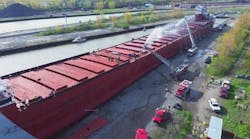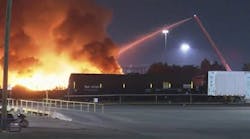Once the burning Ben Franklin five-and-dime store in downtown Palatine began to breathe in and out — the intensifying pressure preparing to blow out the windows and cave in the roof — that was the unmistakable sign for everyone to pull out.
But word quickly spread among the firemen that three of their brothers were unaware how dangerous the situation had grown.
Volunteer firefighters Warren Ahlgrim, Richard Freeman and John Wilson died in the Feb. 23, 1973, fire, their emptied air packs no match against a seemingly innocuous basement filled with few flames but plenty of carbon monoxide.
"Everyone wanted to save Johnny's store, and nobody realized what kind of danger they were in," former Palatine firefighter George Palmer said. "They were good at eating smoke, but had they not had their air packs, they probably would have come out sooner. It was the brave thing to do. But in retrospect, they shouldn't have gone in."
Their deaths, which forever changed a community and highlighted the need for more modern equipment and tactics, are being remembered 40 years later by a department that refuses to forget past tragedies if it means keeping today's members safe.
Responding
Everyone in Palatine knew the Ben Franklin variety store.
Located in the heart of the quaint but expanding downtown district, that was the spot where kids with modest allowances could comb through long shelves stuffed with candy, baseballs and model airplanes.
Most mornings, before the sun came up, welding shop owner Charlie Altman would drive past the Brockway Street staple after grabbing breakfast at a local diner. It was about 5:45 a.m. Feb. 23 when Altman noticed smoke wafting from the building. He called the fire department, which began the usual round of calls to its firefighters, most of whom were still home in bed.
Among them was David Tobin, who lived about a mile away and counted himself among the 30 or so volunteers who made up almost the entire department.
Just as eager to respond was son John Tobin, who, despite being a senior at Palatine High School, was as much a mainstay at those fires as the men charged with extinguishing them. He had grown up with the department and for the past few years had taken photos, cleaned up debris and helped with the hoses, occasionally suiting up alongside the men he idolized.
Whenever a call came in, John usually would make a beeline next door to Assistant Chief Barney Langer's so they could drive directly to the fire while his dad went to the station to get a truck. But this was a Friday morning, and the 18-year-old was avoiding his dad, afraid he'd be ordered to school, and missed his ride.
Tobin started to jog to the store. He quickly realized this would be a biggie.
"I'd never seen so much smoke in my life," said Tobin, now with the Elgin Fire Department and nearing the end of his 35-year career. "And then I heard those four outrigger plates clang on the ground, which told me they were setting up the Snorkel."
Running out of air
The Snorkel was the department's big ladder truck. Often at its helm was Palmer, who remembers that morning as if it was yesterday.
At 42, Palmer was beyond the age cutoff to apply for a full-time gig with Palatine, which was slowly moving away from a volunteer department as ambulance runs became a key part of the fire service and the volume of calls started to skyrocket.
Palmer operated the Snorkel at the Ben Franklin fire, giving crews a bird's-eye view of the blaze.
It seemed manageable at first.
The main floor was smokey but clear of flames. Firefighter John Wilson, 40, owned the store and figured the furnace was the likely culprit.
He led Richard "Dick" Freeman, 25, and Warren "Auggie" Ahlgrim, 32, through the building he knew so well. To access the basement, they had to make their way through the long, narrow structure to a set of interior stairs.
Each man was equipped with an air pack. Based on the atmosphere, lung capacity and exertion, their oxygen might last anywhere from about 10 to 20 minutes.
At one point, Wilson came upstairs and got another line from Tobin's dad, saying the fire was pretty much snuffed. That was the last time anyone saw him alive, as the fire, in fact, had spread.
Tobin and high school classmate Rick Cartwright both had their cameras at the scene and captured gut-wrenching shots of firefighter Howie Freeman working to put out the blaze, and later being held back from trying to rescue his son.
Crews eventually removed the bodies once the structure was safe enough to enter.
"We all stood there silently and respectfully while each of them were loaded into the ambulances," said Tobin, who recently wrote a book about the fire. "The whole town was affected. I know I've never been the same."
Most of the men made their way across the street to the Slade Street fire station to warm up. They were so devastated that the Arlington Heights Fire Department left an engine there to respond to Palatine's calls that night.
Forty years later, Rose Ahlgrim, who could see the smoke from her house, smiles when she thinks about her late husband, "Auggie." They grew up on the same Northwest Highway block and played together as kids. He passed along his love of ice skating and horses to their two children, even buying their daughter a quarter horse for her grade-school graduation.
But she chokes up whenever she remembers receiving the news he had died.
"My father had come," she recalled. "He popped in for coffee every once in a while. He said he had been by the fire and that some of the guys had been trapped. And he started to cry. Then I saw my brother-in-law walk around to the back door. He was a firefighter, too. I ran to the door, and he just hung his head. He didn't have to say anything."
Rose Ahlgrim was overwhelmed by the outpouring of support her family received. She never considered leaving the area, calling herself "an old-time Palatinian."
As she does every year, she plans on attending Saturday's 9 a.m. service at the Palatine Firefighters Memorial at Brockway and Slade streets.
"I know it's done our hearts good to see they are remembered," Ahlgrim said.
A new era
The basics of firefighting haven't changed since 1973: Crews still have to locate the fire, get to the seed of it, put water on it and vent the smoke.
What's radically different, Palatine Fire Chief Scott Andersen said, is the equipment.
Today, firefighters are fully encapsulated in pants, a jacket and hood so no skin is exposed. Every firefighter who goes into a building has his own radio with an emergency alert button. PASS devices (Personal Alert Safety System) are on every air pack now so that whenever someone is motionless for a certain period, it sounds a graduated tone that gets louder. And thermal imaging cameras allow firefighters to see through the smoke.
Andersen said certain tactics have changed as well, such as having dedicated rapid intervention teams whose sole assignment at a fire is to rescue downed firefighters.
"Another big thing to note is that back when you had volunteers, they had to be notified at home and then travel to the station," Andersen said. "Now, you've got guys that would have been on that scene in less than five minutes."
Andersen said that every time a firefighter — no matter where in the U.S. — dies in the line of duty, each station posts the individual's name, age, rank and a brief description of what happened. They keep a running total of deaths as well.
"Every time they go out, they see that board," Andersen said. "And when they get back, they see that board. Not only does it honor those that made the ultimate sacrifice, but it's an opportunity to do research and learn."
Copyright 2013 Paddock Publications, Inc.






